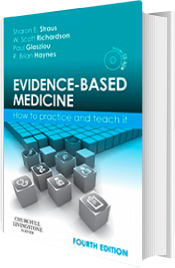You are responsible for the provision of psychiatric services to the local homeless people in an inner city area. Many of your patients suffer from schizophrenia. Although the outpatient clinic you run in a local hostel seems to help stabilise their symptoms, you find that resettling the patients from the hostel to alternative accommodation is difficult and often results in failure. You want to know if there is a model of service that will make it more likely for resettlement to be successful . You formulate the clinical question: “In homeless patients with schizophrenia, is there an intervention that will reduce the rates of homelessness following resettlement?
You go to the Centre for Evidence-Based Mental Health website and search through the titles. You find an abstract and commentary looking at the effectiveness of a “critical time” intervention that looks promising and you decide to get the original article Am J Public Health 1997 Feb; 87: 256-62.
Read the article and decide:
- Is the evidence from this randomised trial valid?
- If valid, is this evidence important?
- If valid and important, can you apply this evidence in caring for your patient?
Completed Therapy Worksheet for Evidence-Based Mental Health
Citation
Susser E, Valencia E, Conover S, et al. Preventing recurrent homelessness among mentally ill men: a ‘critical time’ intervention after discharge from a shelter. Am J Public Health 1997 Feb; 87: 256-62.
Are the results of this single preventive or therapeutic trial valid?
- Was the assignment of patients to treatments randomised?
- And was the randomisation list concealed?
- Yes, but there is no mention of the method of concealment of allocation.
- Were all patients who entered the trial accounted for at its conclusion?
- And were they analysed in the groups to which they were randomised?
- Yes – two usual care participants were lost to follow-up but they were rated as being free from homelessness during the follow-up period – this would produce a conservative estimate of the relative effectiveness of the “critical time” intervention.
- Were patients and clinicians kept “blind” to which treatment was being received?
- No – this was impractical due to the nature of the interventions.
- Aside from the experimental treatment, were the groups treated equally?
- Hard to say from the paper.
- Were the groups similar at the start of the trial?
- Yes – although there may have been slightly more cocaine dependence and less lifetime homelessness in the usual services only group.
Are the valid results of this randomised trial important?
Sample Calculations
| More than 54 nights of homelessness | Relative Risk Reduction (RRR) | Absolute Risk Reduction (ARR) | Number Needed to Treat (NNT) | |
|---|---|---|---|---|
| Usual services onlyControl Event Rate (CER) | “Critical time” InterventionExperimental Event Rate (EER) | (CER – EER)/CER | CER-EER | 1/ARR |
| 40% | 21% |
(40%-21%)/40% = 47% |
40% – 21% = 19% |
1/19% = 5 pts |
begin{align}
text{95% Confidence Interval (CI) on an NNT} &= 1 / text{(limits on the CI of its ARR)} \\
&= pm 1.96 sqrt{frac{CER times (1-CER)}{text{# of control pts.}}+ frac{EERtimes(1-EER)}{text{# of exper. pts.}}}\\
&= pm 1.96 sqrt{(frac{0.40 times 0.60}{48} + frac{0.21×0.79}{48}}\\
&= pm 18%
end{align}
Can you apply this valid, important evidence about a treatment in caring for your patient?
Do these results apply to your patient?
- Are your patients so different from those in the trial that its results can’t help you?
- No, they are similar to those included in the trial – although there might be differences between the US and elsewhere
- How great would the potential benefit of therapy actually be for your individual patient?
- Method I: f
$$ text{Risk of the outcome in your patient, relative to patients in the trial. expressed as a decimal: 1.0}\\
NNT/F = 5/1 = 5 \\
text{(NNT for patients like yours)}$$ -
Method II: 1 / (PEER x RRR)
$$ text{Your patient’s expected event rate if they received the control treatment: PEER:______}\\
1 / (PEER times RRR)\\
= 1/underline{qquad qquad}\\
= underline{qquad qquad}\\
text{(NNT for patients like yours)}$$
Are your patient’s values and preferences satisfied by the regimen and its consequences?
- Do your patient and you have a clear assessment of their values and preferences?
- Needs to be assessed in each patient.
- Are they met by this regimen and its consequences?
- Needs to be assessed in each patient.
Additional Notes
–
Homelessness – “Critical Time” intervention decreased risk
Clinical Bottom Line
A “critical time” time intervention decreased homelessness in mentally ill men.
Citation
Susser E, Valencia E, Conover S, et al. Preventing recurrent homelessness among mentally ill men: a ‘critical time’ intervention after discharge from a shelter. Am J Public Health 1997 Feb; 87: 256-62.
Clinical Question
In a mentally ill homeless person, does a “critical time” intervention prevent extended homelessness?
Search Terms
“homelessness” in Evidence-Based Mental Health
The Study
Randomised controlled trial with intention-to-treat analysis. Patients discharged from an on-site psychiatry programme in a New York City men’s shelter.
Control Group:
(N = 48; 48 analysed): usual services only.
Experimental Group:
(N = 48; 48 analysed): “critical time” intervention – an intervention aimed at strengthening an individual’s ties to services, family and friends and providing emotional and practical support during transition from hostel to alternative accommodation.
The Evidence
| Outcome | Time to Outcome | CER | EER | RRR | ARR | NNT |
|---|---|---|---|---|---|---|
| Extended homelessness (>54 days) | 18 months | 0.40 | 0.21 | 0.47 | 0.19 | 5 |
| 95% Confidence Intervals: | 1 to 73 | 3 to 100 | ||||
| Control mean | Exp mean | Difference between the means | 95% CI | |||
| Days homeless | 18 months | 91 | 30 | 61 | 19 to 105 | |
Appraised By
Geddes 1999.
Expiry Date
2000

